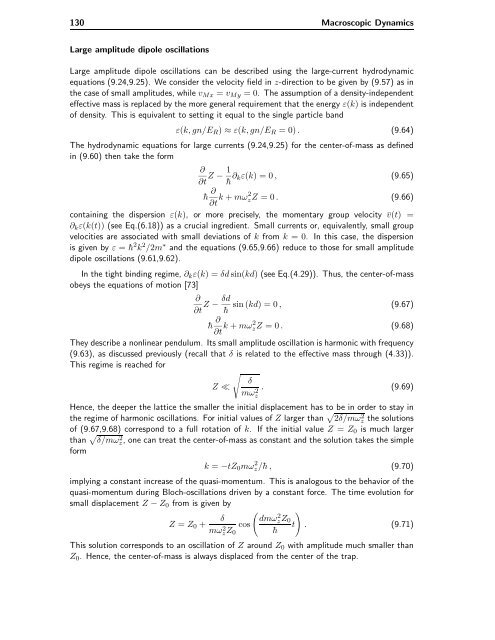Bose-Einstein Condensates in Rotating Traps and Optical ... - BEC
Bose-Einstein Condensates in Rotating Traps and Optical ... - BEC
Bose-Einstein Condensates in Rotating Traps and Optical ... - BEC
You also want an ePaper? Increase the reach of your titles
YUMPU automatically turns print PDFs into web optimized ePapers that Google loves.
130 Macroscopic Dynamics<br />
Large amplitude dipole oscillations<br />
Large amplitude dipole oscillations can be described us<strong>in</strong>g the large-current hydrodynamic<br />
equations (9.24,9.25). We consider the velocity field <strong>in</strong> z-direction to be given by (9.57) as <strong>in</strong><br />
the case of small amplitudes, while vMx = vMy =0. The assumption of a density-<strong>in</strong>dependent<br />
effective mass is replaced by the more general requirement that the energy ε(k) is <strong>in</strong>dependent<br />
of density. This is equivalent to sett<strong>in</strong>g it equal to the s<strong>in</strong>gle particle b<strong>and</strong><br />
ε(k, gn/ER) ≈ ε(k, gn/ER =0). (9.64)<br />
The hydrodynamic equations for large currents (9.24,9.25) for the center-of-mass as def<strong>in</strong>ed<br />
<strong>in</strong> (9.60) then take the form<br />
∂ 1<br />
Z −<br />
∂t ¯h ∂kε(k) =0, (9.65)<br />
¯h ∂<br />
∂t k + mω2 zZ =0. (9.66)<br />
conta<strong>in</strong><strong>in</strong>g the dispersion ε(k), or more precisely, the momentary group velocity ¯v(t) =<br />
∂kε(k(t)) (see Eq.(6.18)) as a crucial <strong>in</strong>gredient. Small currents or, equivalently, small group<br />
velocities are associated with small deviations of k from k =0. In this case, the dispersion<br />
is given by ε =¯h 2 k2 /2m∗ <strong>and</strong> the equations (9.65,9.66) reduce to those for small amplitude<br />
dipole oscillations (9.61,9.62).<br />
In the tight b<strong>in</strong>d<strong>in</strong>g regime, ∂kε(k) =δd s<strong>in</strong>(kd) (see Eq.(4.29)). Thus, the center-of-mass<br />
obeys the equations of motion [73]<br />
∂ δd<br />
Z − s<strong>in</strong> (kd) =0, (9.67)<br />
∂t ¯h<br />
¯h ∂<br />
∂t k + mω2 zZ =0. (9.68)<br />
They describe a nonl<strong>in</strong>ear pendulum. Its small amplitude oscillation is harmonic with frequency<br />
(9.63), as discussed previously (recall that δ is related to the effective mass through (4.33)).<br />
This regime is reached for<br />
<br />
δ<br />
Z ≪ . (9.69)<br />
mω 2 z<br />
Hence, the deeper the lattice the smaller the <strong>in</strong>itial displacement has to be <strong>in</strong> order to stay <strong>in</strong><br />
the regime of harmonic oscillations. For <strong>in</strong>itial values of Z larger than 2δ/mω2 z the solutions<br />
of (9.67,9.68) correspond to a full rotation of k. If the <strong>in</strong>itial value Z = Z0 is much larger<br />
than δ/mω2 z, one can treat the center-of-mass as constant <strong>and</strong> the solution takes the simple<br />
form<br />
k = −tZ0mω 2 z/¯h, (9.70)<br />
imply<strong>in</strong>g a constant <strong>in</strong>crease of the quasi-momentum. This is analogous to the behavior of the<br />
quasi-momentum dur<strong>in</strong>g Bloch-oscillations driven by a constant force. The time evolution for<br />
small displacement Z − Z0 from is given by<br />
δ<br />
Z = Z0 +<br />
<br />
dmω2 zZ0<br />
cos t .<br />
¯h<br />
(9.71)<br />
mω 2 zZ0<br />
This solution corresponds to an oscillation of Z around Z0 with amplitude much smaller than<br />
Z0. Hence, the center-of-mass is always displaced from the center of the trap.




